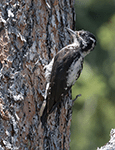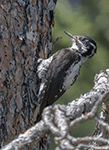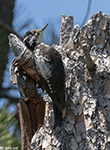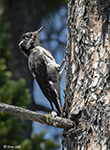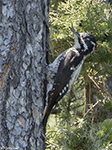| Length: 8 to 9 inches | Wingspan: 14 to 16 inches | Seasonality: All Seasons |
| ID Keys: Black barring on sides, yellow cap (males), black head with white mustache, white on back | ||
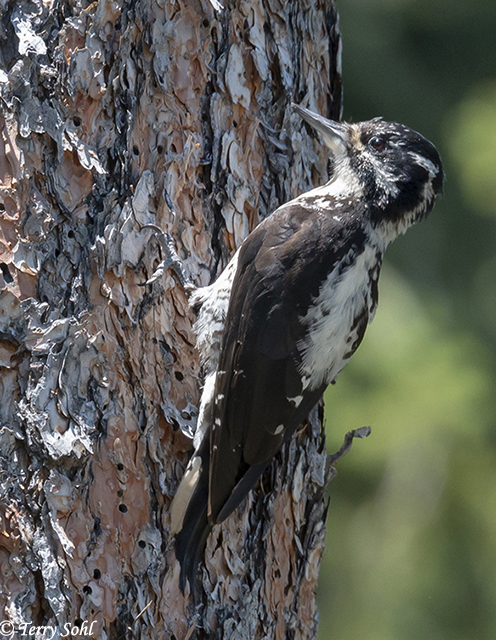 The Three-toed Woodpecker
is a small woodpecker of western North America, much of Canada, and down into
New England. They can often be
overlooked, as they're not a particularly vocal species, and often will forage
by working over one individual tree for quite some time. They are strongly associated with spruce forests, and are very found
of the larvae of spruce bark beetle. Until 2005, the species was considered to
be the same as the Eurasian three-toed Woodpecker (now Picoides tridactylus).
The Three-toed Woodpecker
is a small woodpecker of western North America, much of Canada, and down into
New England. They can often be
overlooked, as they're not a particularly vocal species, and often will forage
by working over one individual tree for quite some time. They are strongly associated with spruce forests, and are very found
of the larvae of spruce bark beetle. Until 2005, the species was considered to
be the same as the Eurasian three-toed Woodpecker (now Picoides tridactylus).
In South Dakota, they are found exclusively in the Black Hills, where they are permanent residents. They are most often found in higher-elevation areas of the Black Hills that have older spruce tree forests, or in and around recently burned areas with extensive standing dead timber.
Habitat:
Found in conifer forests of the West, most often being associated with spruce. They are also very often found in areas with dead standing trees, such as those killed by fire or flood, as wood-boring insect infestations tend to favor these areas.
Diet:
Primarily feeds on the larvae of wood-boring beetles. Also eats other insects, fruit, berries, and will occasionally consume sap from sapsucker bore wells.
Behavior:
American Three-toed Woodpeckers typically forages on conifer trees, moving deliberately and scaling off the bark to gain access to insects underneath. They are usually solitary outside of the breeding season, although densities of birds in favorable areas such as recently burned forests may bring several birds into the same general vicinity.
Nesting:
June and July. American Three-toed Woodpeckers nest in tree cavities, usually constructed in a dead conifer tree, but they will also sometimes create a cavity in a live tree. They have often been known to construct cavities in wooden power-line poles. Both the male and female American Three-toed Woodpecker share responsibilities during the breeding season, as both help to construct the nest and incubate the young. The female lays between 3 and 6 eggs, with the incubation period lasting about 2 weeks.
Song / Vocalizations:
American Three-toed Woodpeckers aren't a particularly vocal species. The most commonly heard vocalization is a sharp pic call. They also have a rattling call, and drumming that usually often rapid in pace and slows towards the end.
1Click here to hear a pic call series from a male American Three-toed Woodpecker
2Click here to hear interaction calls among three American Three-toed Woodpeckers
Migration:
Most are permanent residents, although those in northern Canada may move southward a short distance in winter and others may move from higher to lower elevations.Most are permanent residents, although those in northern Canada may move southward a short distance in winter and others may move from higher to lower elevations.
Interactive eBird map:
Click here to access an interactive eBird map of Three-toed Woodpecker sightings
Similar Species:
American Three-toed Woodpeckers could potentially be confused with other small, black-and-white woodpecker species. The following are the species most likely to cause identification issues:
- Black-backed Woodpecker - Both Black-backed and American Three-toed Woodpeckers are often found in areas of recent forest disturbance, and thus may potentially found utilizing the same habitats. They gravitate towards burned areas or other areas with dead trees due to the insects that can be found. In terms of identification, they are both very similarly structurally and in plumage, but the Black-backed Woodpecker does indeed have a completely black back, while an American Three-toed Woodpecker has a white patch on the back.
- Hairy Woodpecker - Hairy Woodpeckers have a vast range in North America, a range that nearly fully encompasses that of the Black-backed Woodpecker. Hairy Woodpeckers are slightly larger on average, although the difference is small and not likely to be useful ID mark in the field. Hairy Woodpeckers have clean white undersides and flanks, while the flanks of an American Three-toed Woodpecker have black barring/markings. The white patch on the back of a Hairy Woodpecker also is "cleaner", as a coherent white patch, while the white on an American Three-toed Woodpecker's back often presents as black and white barring. Male Hairy Woodpeckers have a red patch on the back of the head, while male American Three-toed Woodpeckers have a yellow patch on their crown.
- Downy Woodpecker - Like the Hairy Woodpecker, Downy Woodpeckers have a very broad range in North America, a range that overlaps with that of an American Three-toed Woodpecker. Downy Woodpeckers are the smallest of the species listed here, but again, size is sometimes difficult to judge in the field. Downy Woodpeckers have clean white undersides and flanks, compared to the black barring/marking on the flank of an American Three-toed Woodpecker. Male Downy Woodpeckers have a red patch on the back of the head, while male American Three-toed Woodpeckers have a yellow patch on their crown.
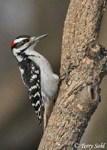 |
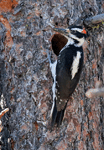 |
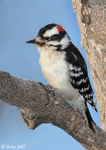 |
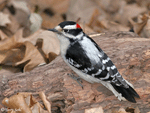 |
| Hairy Woodpecker | Hairy Woodpecker | Downy Woodpecker | Downy Woodpecker |
South Dakota "Hotspot":
American Three-toed Woodpeckers are only found in the Black Hills of South Dakota. They can be found in and around two specific types of habitats in the Black Hills...recently burned areas with dead standing timber, and higher-elevation areas with spruce trees. Examples of higher-elevation areas where they might be found include the Sylvan Lake area and up towards Black Elk Peak, or further north in the hills, in the higher elevation spruce areas near Hanna Campground.
Conservation Status: Systematic surveys show generally stable numbers overall, in both its Eurasian and North American ranges. Although they can fluctuate with availability of suitable habitat, they are found across a very broad geographic area and are relatively common in parts of that range. The IUCN considers the Three-toed Woodpecker to be a species of "Least Concern".
Further Information:
1) BirdWeb - American Three-toed Woodpecker
2) Audubon Guide - AmericanThree-toed Woodpecker-toed Woodpecker
3) WhatBird - AmericanThreee-toed Woodpecker
Photo Information:
July 13th, 2021 - Near Mystic, in the Black Hills of South Dakota - Terry Sohl
Audio File Credits:
1David Tonnessen. Recorded in Teller County, Colorado on January 19th, 2018. Original recording and information available from xeno-canto.
2Andrew Spencer. Recorded in Eagle County, Colorado on June 1st, 2012. Original recording and information available from xeno-canto.
3Andrew Spencer. Recorded in Jackson County, Colorado on July 8th, 2007. Original recording and information available from xeno-canto.
| Click on the map below for a higher-resolution view |
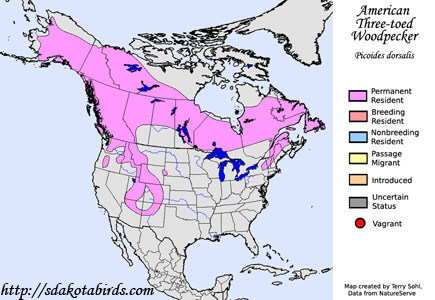 |
| South Dakota Status: Rare permanent resident in the higher elevations of the Black Hills. |
Additional Three-toed Woodpecker Photos
